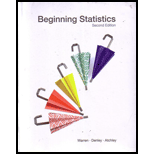
The multiple regression equation and define each of the variables used in the multiple regression equation. Also check any one of the explanatory variables be eliminated from the model and mention it.
Answer to Problem 8E
Solution:
The multiple regression equation for the given table is
Explanation of Solution
Formula Used:
Multiple Regression Model:
A multiple regression model is a linear regression model using two or more explanatory variable to predict a response variable, given by
Where
Null and Alternative Hypothesis for an ANOVA test:
The null and alternative hypotheses for an ANOVA test to analyse the statistical significance of the linear relationship between the variables in a multiple regression model as follows.
Conclusions Using
If
If
The ANOVA table given as follows:
| Intercept | -0.616112354 | 0.345507101 | -1.783211841 | 0.092415337 |
| High School GPA | 0.975068267 | 0.186279465 | 5.234437779 | 6.7297E-05 |
| ACT Score | 0.015000337 | 0.019048101 | 0.787497806 | 0.441832554 |
The block of information gives the coefficients of the multiple regression equation and the coefficients of the explanatory variables.
The first row of the coefficient column gives the predicted value for the y-intercept,
Substituting the estimated coefficients into the multiple regression model, we have the following equation for predicting the college freshman GPA after their first year based on their high school GPAs,
Let’s consider the individual explanatory variables more closely. Look at the
| 0.092415337 |
| 6.7297E-05 |
| 0.441832554 |
The
The null and alternative hypotheses for the first explanatory variable would be as follows.
The null and alternative hypotheses for the other explanatory variables are similar. A small
If the
In this case of predicting the college freshman GPA after their first year, notice that the
Similarly, the
Thus, including freshman’s ACT scores in the multiple regression model may not be useful. Need to recalculate the multiple regression model without this variable. However, that the
Therefore, it needs to eliminate the second explanatory variable, college freshman’s ACT scores, as it is not statistically significant.
Final Statement:
The multiple regression equation for the given table is
Want to see more full solutions like this?
Chapter 12 Solutions
Beginning Statistics, 2nd Edition
 MATLAB: An Introduction with ApplicationsStatisticsISBN:9781119256830Author:Amos GilatPublisher:John Wiley & Sons Inc
MATLAB: An Introduction with ApplicationsStatisticsISBN:9781119256830Author:Amos GilatPublisher:John Wiley & Sons Inc Probability and Statistics for Engineering and th...StatisticsISBN:9781305251809Author:Jay L. DevorePublisher:Cengage Learning
Probability and Statistics for Engineering and th...StatisticsISBN:9781305251809Author:Jay L. DevorePublisher:Cengage Learning Statistics for The Behavioral Sciences (MindTap C...StatisticsISBN:9781305504912Author:Frederick J Gravetter, Larry B. WallnauPublisher:Cengage Learning
Statistics for The Behavioral Sciences (MindTap C...StatisticsISBN:9781305504912Author:Frederick J Gravetter, Larry B. WallnauPublisher:Cengage Learning Elementary Statistics: Picturing the World (7th E...StatisticsISBN:9780134683416Author:Ron Larson, Betsy FarberPublisher:PEARSON
Elementary Statistics: Picturing the World (7th E...StatisticsISBN:9780134683416Author:Ron Larson, Betsy FarberPublisher:PEARSON The Basic Practice of StatisticsStatisticsISBN:9781319042578Author:David S. Moore, William I. Notz, Michael A. FlignerPublisher:W. H. Freeman
The Basic Practice of StatisticsStatisticsISBN:9781319042578Author:David S. Moore, William I. Notz, Michael A. FlignerPublisher:W. H. Freeman Introduction to the Practice of StatisticsStatisticsISBN:9781319013387Author:David S. Moore, George P. McCabe, Bruce A. CraigPublisher:W. H. Freeman
Introduction to the Practice of StatisticsStatisticsISBN:9781319013387Author:David S. Moore, George P. McCabe, Bruce A. CraigPublisher:W. H. Freeman





